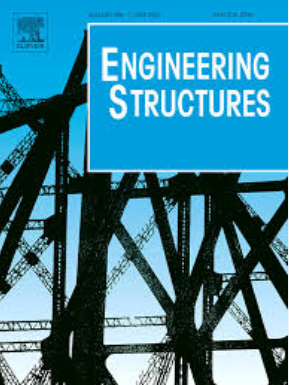考虑装饰层影响的钢-再生骨料混凝土连续组合梁长期性能研究
IF 5.6
1区 工程技术
Q1 ENGINEERING, CIVIL
引用次数: 0
摘要
钢-再生骨料混凝土组合梁(sraccb)是再生骨料混凝土(RAC)应用的首选构件。钢-混凝土组合梁由于其优越的跨越能力和承载能力,通常比传统的梁构件更细长,这使得它们对混凝土的收缩和徐变更敏感。此外,再生骨料(RA)的掺入显著增加了混凝土的收缩和徐变变形。因此,RAC的长期性能显著影响sraccb的应用。事实上,RAC的收缩和蠕变与边界条件密切相关,钢甲板和装饰层的密封效果直接影响sccb的长期变形。但是,目前还没有相关的研究。在此背景下,本文对连续SRACCB(4 m × 2跨度)进行了500天的长期性能试验。试验量化了加装RA和加装装饰层对sraccb跨中挠度和端部相对滑移的影响。考虑RAC的开裂、收缩、蠕变和界面处的长期滑移,建立了sraccb的直接刚度法有限元模型。试验结果表明,采用100 % RA可使试件跨中挠度提高27.9 %,相对滑移提高54.8 %;装饰层安装90天可使跨中挠度降低16.3 %,相对滑移降低11.5 %。12组试验数据的验证结果表明,所提出的DSMFEM具有较高的计算效率,可以有效地预测简支梁和连续梁的挠度和相对滑移。在长期荷载作用下预测最终跨中挠度的最大误差为6.8% %,在无荷载作用下预测最终跨中挠度的最大误差为18.4% %。本文章由计算机程序翻译,如有差异,请以英文原文为准。
Long-term performance of steel-recycled aggregate concrete continuous composite beams considering the influence of installing decorative layers
Steel-recycled aggregate concrete composite beams (SRACCBs) are preferred components for the recycled aggregate concrete (RAC) application. Due to their superior spanning ability and load-bearing capacity, steel-concrete composite beams (SCCBs) are typically more slender than traditional beam components, which makes them more sensitive to concrete shrinkage and creep. Furthermore, the incorporation of recycled aggregate (RA) significantly increases the shrinkage and creep deformation of the concrete. Therefore, the long-term properties of RAC significantly affect the application of SRACCBs. In fact, the shrinkage and creep of RAC are closely related to the boundary conditions, and the sealing effect of the steel deck and decorative layer can directly influence the long-term deformation of SCCBs. However, relevant research is currently unavailable. In this context, a 500-day long-term performance test of continuous SRACCB (4 m × 2 spans) was conducted in this paper. The test quantified the effects of incorporating RA and installing decorative layers on the mid-span deflection and end relative slip of the SRACCBs. By considering the cracking, shrinkage, and creep of RAC and long-term slip at the interface, a Direct Stiffness Method Finite Element Model (DSMFEM) for SRACCBs was established. Test results indicate that using 100 % RA can increase the mid-span deflection of the specimen by 27.9 % and the relative slip by 54.8 %; a 90-day installation of the decoration layer can lead to a 16.3 % decrease in the mid-span deflection and an 11.5 % decrease in the relative slip. The verification results of 12 sets of experimental data indicate that the proposed DSMFEM has high computational efficiency and can effectively predict the deflection and relative slip of simply-supported and continuous SCCBs. The maximum error in predicting the final mid-span deflection is 6.8 % for specimens with long-term loads and 18.4 % for specimens without loads.
求助全文
通过发布文献求助,成功后即可免费获取论文全文。
去求助
来源期刊

Engineering Structures
工程技术-工程:土木
CiteScore
10.20
自引率
14.50%
发文量
1385
审稿时长
67 days
期刊介绍:
Engineering Structures provides a forum for a broad blend of scientific and technical papers to reflect the evolving needs of the structural engineering and structural mechanics communities. Particularly welcome are contributions dealing with applications of structural engineering and mechanics principles in all areas of technology. The journal aspires to a broad and integrated coverage of the effects of dynamic loadings and of the modelling techniques whereby the structural response to these loadings may be computed.
The scope of Engineering Structures encompasses, but is not restricted to, the following areas: infrastructure engineering; earthquake engineering; structure-fluid-soil interaction; wind engineering; fire engineering; blast engineering; structural reliability/stability; life assessment/integrity; structural health monitoring; multi-hazard engineering; structural dynamics; optimization; expert systems; experimental modelling; performance-based design; multiscale analysis; value engineering.
Topics of interest include: tall buildings; innovative structures; environmentally responsive structures; bridges; stadiums; commercial and public buildings; transmission towers; television and telecommunication masts; foldable structures; cooling towers; plates and shells; suspension structures; protective structures; smart structures; nuclear reactors; dams; pressure vessels; pipelines; tunnels.
Engineering Structures also publishes review articles, short communications and discussions, book reviews, and a diary on international events related to any aspect of structural engineering.
 求助内容:
求助内容: 应助结果提醒方式:
应助结果提醒方式:


